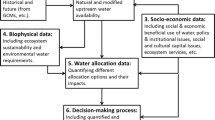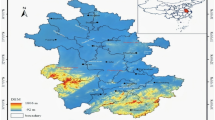Abstract
Assessing the risk to water resources facilities under climate change is difficult because the uncertainty associated with 2xCO2 climate scenarios cannot be readily quantified. Grey systems theory is used to develop a grey prediction model (GPM) that provides an interval of uncertainty. The GPM is used to extrapolate a numerical interval around the decadal averages of precipitation and temperature through the year 2010 for a site in Northwestern Canada. The extrapolation is calibrated on 20 years of data and validated against observations for the 1980’s. The values in the 1990’s correspond to observed trends in the area. The temperature and precipitation values are used to develop a grey water balance model. The grey intervals for annual potential evapotransipiration, deficit and surplus are used to evaluate the reliability of a transient and three equilibrium climate change scenarios scenarios. The grey intervals are not coincident with the transient output, but they are trending towards the equilibrium scenario values. This suggests that this particular transient scenario is inadequate for risk assessment, and although the equilibrium scenarios appear to be within the grey interval, they represent years beyond a reliable GPM extrapolation.
Access this chapter
Tax calculation will be finalised at checkout
Purchases are for personal use only
Preview
Unable to display preview. Download preview PDF.
Similar content being viewed by others
References
Bass, B., Russo, J.M. and Schlegel, J.W. (1994) “Data Quality in Weather-Dependent Decisions” (in press).
Cohen, S.J., Welsh, L.E. and Louie, P.Y.T. (1989). Possible impacts of climatic warming scenarios on water resources in the Saskatchewan River sub-basin. Canadian Climate Centre, Report No. 89–9. Available from Climatological Services Division, AES, Downsview, Ontario, Canada.
Cohen, S.J. (1991). “Possible impacts of climatic warming scenarios on water resources in the Saskatchewan River sub-basin, Canada” Climatic Change 19, 291–317.
Deng, J. (1984) The Theory and Methods of Socio-economic Grey Systems (in Chinese), Science Press, Bei**g, China.
Environment Canada (1992) The State of Canada’s Climate: Temperature Change in Canada 1895–1991. SOE Report 92–2.
Huang, G.H. (1988) “A Grey Systems Analysis Method for Predicting Noise Pollution in Urban Areas”, The Third National Conference on Noise Pollution Control, Chengdu, Sichuan, China (in Chinese).
Huang, G.H. and Moore, R.D. (1993) “Grey linear programming, its solving approach, and its application”. International Journal of Systems Science 24, 159–172.
Mather, J.R. (1978). The Climatic Water Balance in Environmental Analysis. Lexington Books, Lexington, Mass. USA
Author information
Authors and Affiliations
Editor information
Editors and Affiliations
Rights and permissions
Copyright information
© 1994 Springer Science+Business Media Dordrecht
About this chapter
Cite this chapter
Bass, B., Huang, G., Yin, Y., Cohen, S.J. (1994). Grey Theory Approach to Quantifying the Risks Associated with General Circulation Models. In: Hipel, K.W., McLeod, A.I., Panu, U.S., Singh, V.P. (eds) Stochastic and Statistical Methods in Hydrology and Environmental Engineering. Water Science and Technology Library, vol 10/3. Springer, Dordrecht. https://doi.org/10.1007/978-94-017-3083-9_3
Download citation
DOI: https://doi.org/10.1007/978-94-017-3083-9_3
Publisher Name: Springer, Dordrecht
Print ISBN: 978-90-481-4379-5
Online ISBN: 978-94-017-3083-9
eBook Packages: Springer Book Archive




